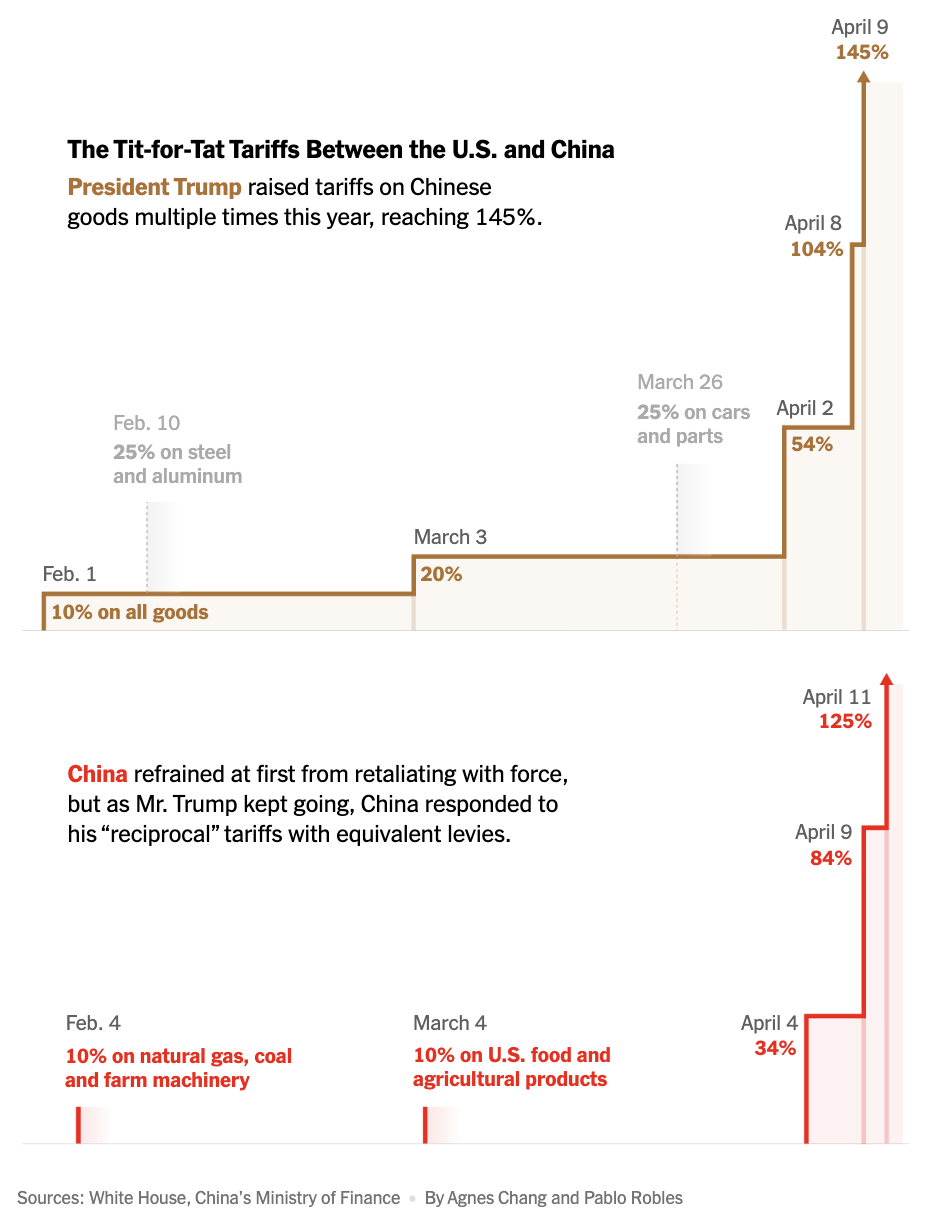The Implications of the China-U.S. Tariff Battle
Graph tracking increases in tariffs between the U.S. and China (Photo Credit: New York Times).
Tariffs are a tax imposed by a government on goods imported from another country, often used to protect domestic industries, raise revenue, or influence trade policies with that country. The impact is higher prices on goods, which is significant for the U.S., as in 2024, 13.4% of all imported goods were from China, totaling $438.9 billion. States like Nevada and California imported nearly a quarter of their goods from China in the same period, indicating that they would be most severely impacted by the tariffs. President Trump has stated previously that tariffs against China, Mexico, and Canada all were in pursuit of addressing the “emergency situation” of “illegal aliens and drugs, including deadly fentanyl,” aiming to stop these flows by using the tax as a political tool. Additionally, he has argued that the universal tariffs, and specifically those from China, will promote U.S. manufacturing and boost jobs—more in line with protecting domestic industry. Yet the tariffs have thrown the U.S. markets into chaos, with the stock market fluctuating rapidly and American consumers predicted to bear the brunt of price increases on a number of goods. Even among supporters of President Trump, the tariffs are unpopular, with a legal group funded by “some of the biggest names in conservative politics” filing lawsuits against the administration due to the negative impact of these taxes upon their businesses.
Graph tracking U.S. and China imports from the other country over time (Photo Credit: BBC).
Conversely, the tariffs placed by China on U.S. imports today—125%—will similarly hurt Chinese consumers. Although China imports far less from the U.S. than vice versa, industries like farming, pharmaceuticals, petroleum, and aircraft will be significantly impacted. Especially considering China’s annual economic growth target of “around 5%,” this is risky.
So considering that the trade war is detrimental to populations on both sides, many are wondering why it continues. Seemingly, President Trump had predicted that increased tariffs would prompt Chinese leaders to “want to make a deal.” Instead, China retaliated with higher tariffs, maintaining that it “foresaw and prepped for this trade war,” with diversification of trade away from the West incorporated into its growth plans. Additionally, Chinese President Xi Jinping, in his first public notes about the tariffs, on Friday argued that “there are no winners in a tariff war,” and that they were “forced to react” in order to “expose the blackmailing nature of the U.S.”
Moving forward, Chinese leaders plan to maintain their retaliatory tariffs, predicting that the U.S. will back down as this “cause doesn’t win the support of the people and will end in failure.” They also continue to file complaints with the World Trade Organization, appealing to international support by arguing that U.S. tariffs on China are “reckless” and “threaten to further destabilize global trade.”
The Trump administration has made it clear to the Chinese government that President Xi should “request a call” with him, which has not occurred and “only dug [President Trump] in further.” Considering this, it is unlikely that President Trump will back down immediately. But as domestic discontent and international pressure rise, perhaps President Trump will reverse course, as he did with the reversal this past week on all other reciprocal tariffs after seeing that the markets—particularly bond yields—were getting “a little bit yippy.”


